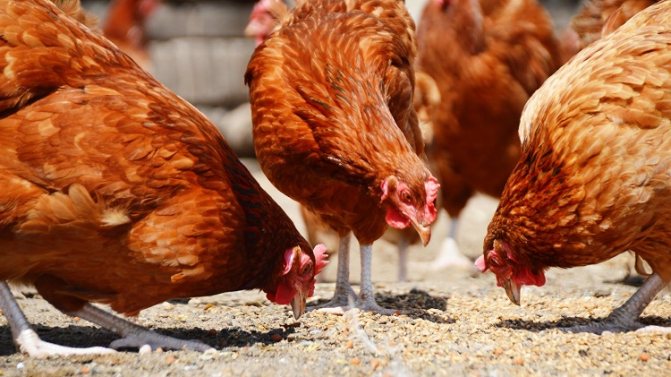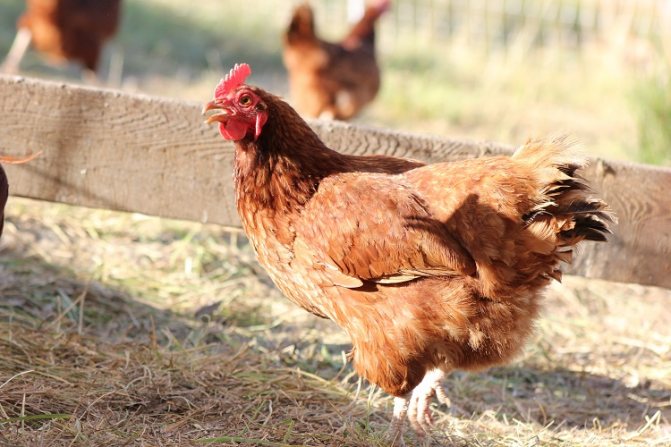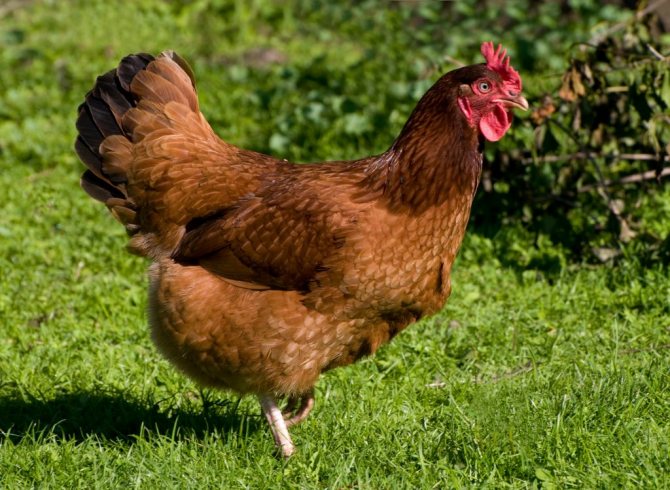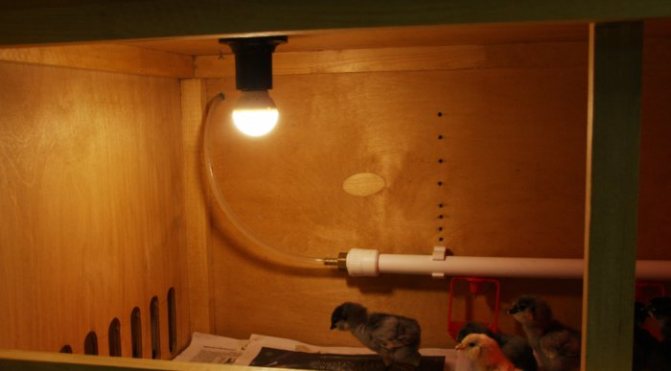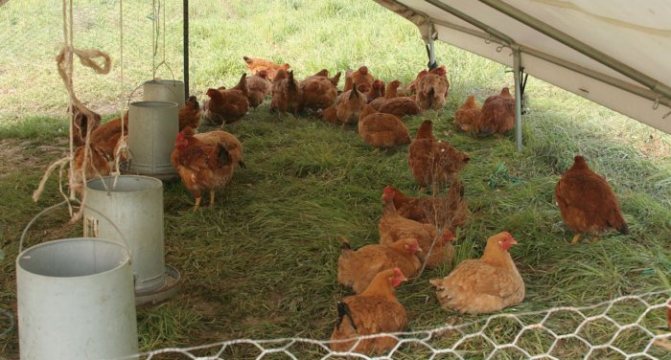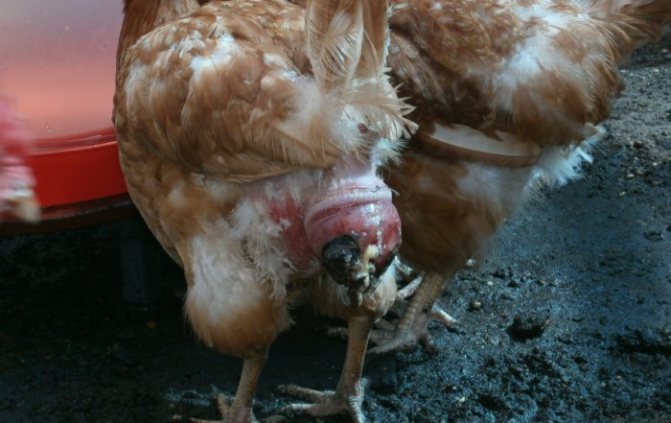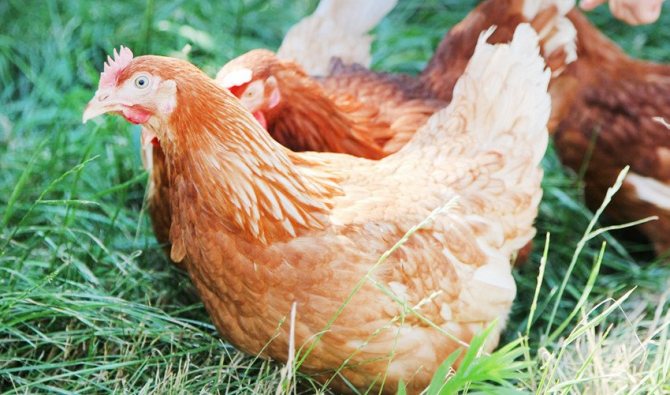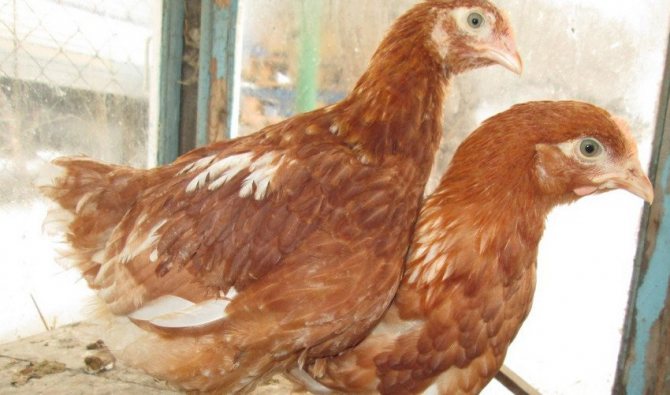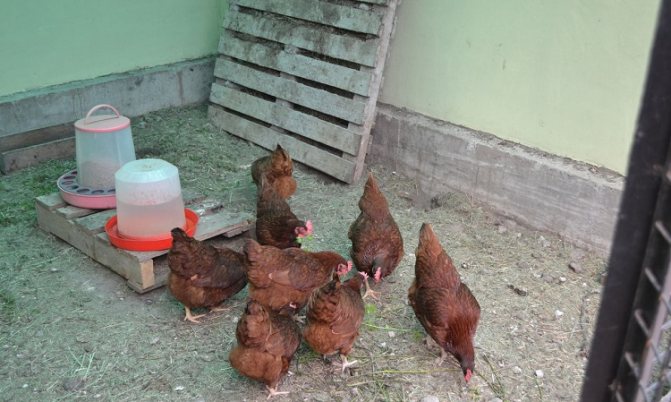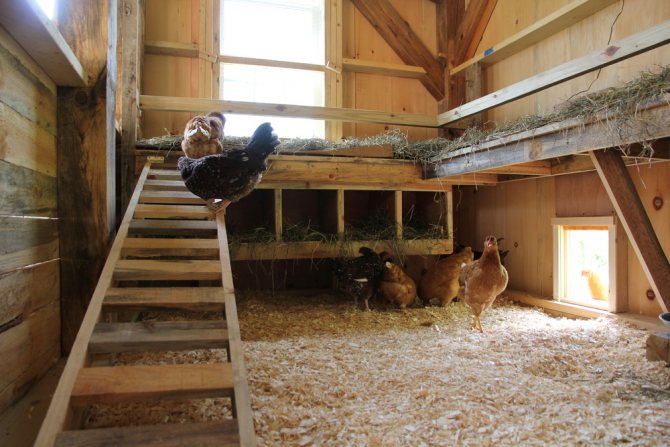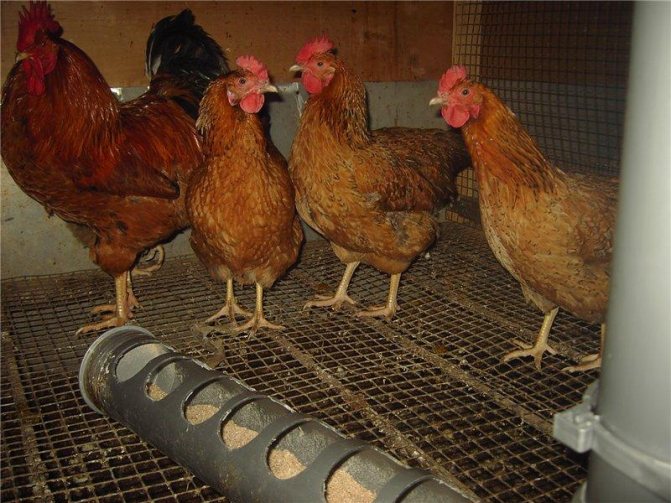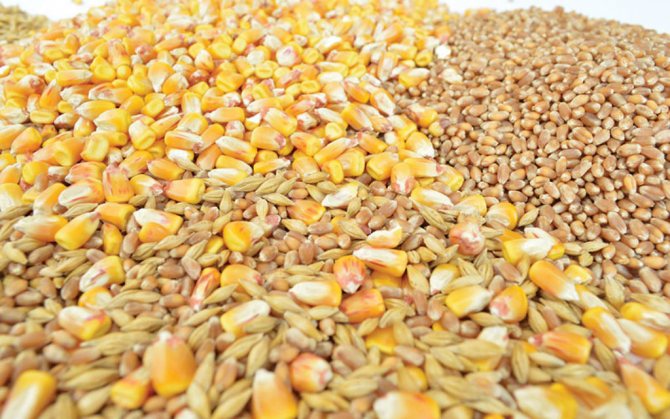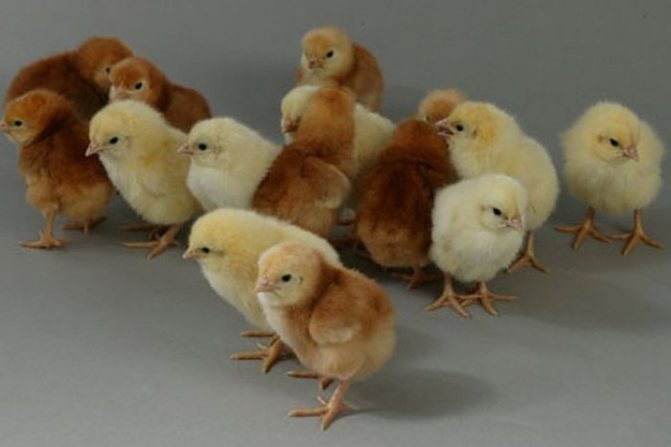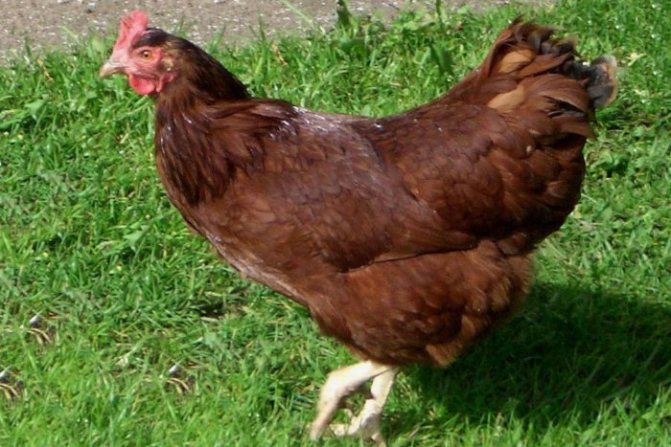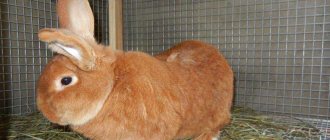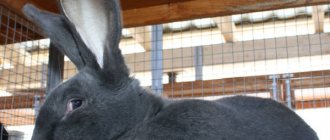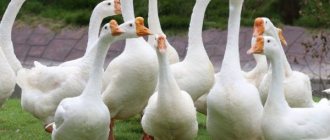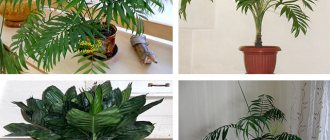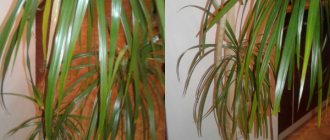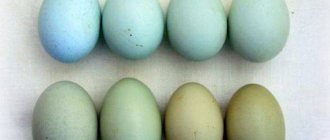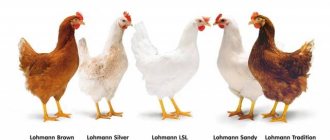The development of Russian breeders, rhodonite chickens, is an industrial egg cross, created at the beginning of the 21st century on the basis of broken brownies and Rhode Islands. The bird is distinguished by high productivity, vitality and good adaptation to the local climate. For those who are faced with the choice of a breed of laying hens for their backyard, it makes sense to get to know this hybrid better.
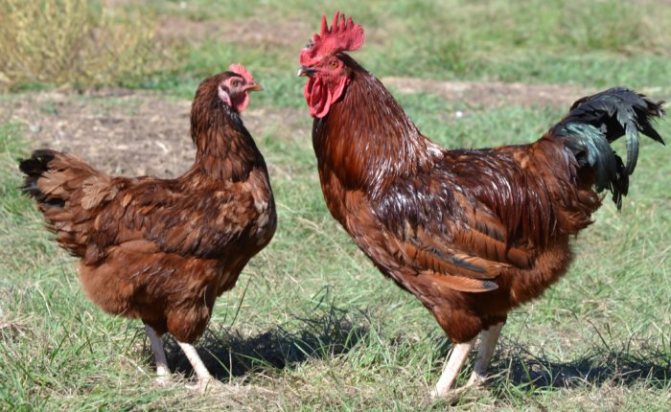
Rooster and hen rhodonite
Breeding history
In the early 2000s, Sverdlovsk breeders began to conduct an experiment in order to obtain a productive breed of chickens with maximum indicators in the number of eggs, which, in addition, would be perfectly adapted to the difficult Russian climate. The final work was to be birds with the following indicators:
- the highest possible egg production;
- the ability to survive in harsh climatic conditions;
- no decrease in egg productivity with the onset of cold weather.
The work lasted for six whole years, and in 2008 the breeders had something to brag about. To form a new breed, the most egg crosses with the highest rates were used. These are the Broken Brown (German breed) and Rhode Islands (American bird). If you look closely at the rhodonites, you can see the characteristic features of both ancestors.
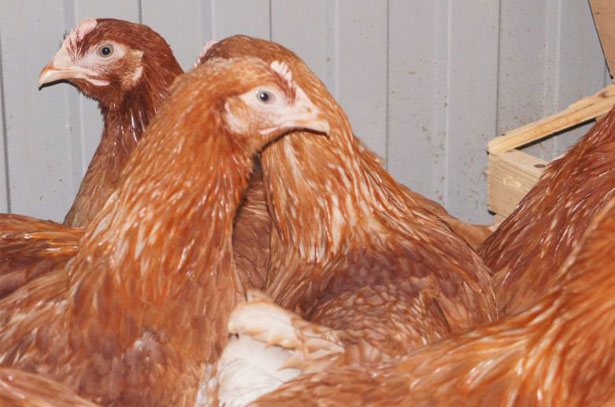

The uniqueness of the new chickens is entirely the merit of the breeders who completed all the tasks set for themselves. Layers do not actually reduce egg production at freezing temperatures. For the sake of the experiment, chickens were placed in rooms without heating, and even there they managed to achieve amazing results.
Features of appearance
Outward signs of rhodonites are similar to those of the Loman Brown and Rhode Islands. Those special traits of which genes the chick has more will prevail more clearly. The size of the head is small, the color of the beak is yellow with a stripe in the middle. The crest is leaf-shaped, red and impressive in size. The color of well-developed earrings is red.
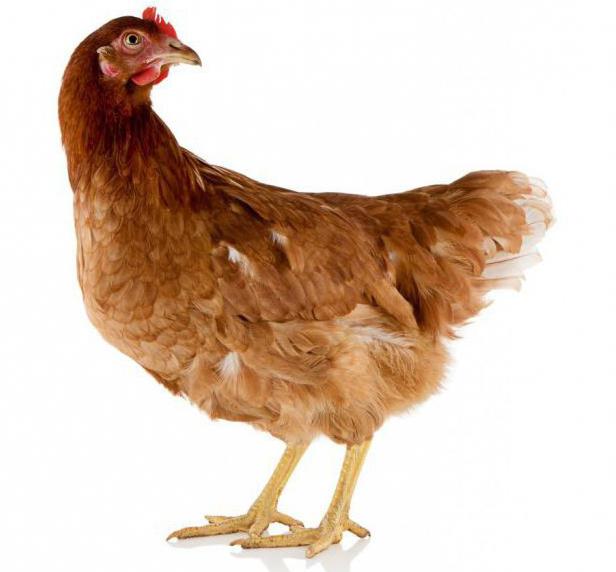

The feather cover is dense and fits well to the body. The most common color is light brown. There is a shade of gray in the tail and wings. The structure of the bones corresponds to oviparous breeds, the skeleton is compact and light.
How to determine gender?
Determining the sex of individuals of the cross rhodonite is not difficult. It is carried out within 24 hours after birth by means of an external examination.
First of all, attention should be paid to fluff on the body.
If it is yellow, then it is a rooster, and if it is brown, then it is a chicken. In addition, the halo around the eyes is light in females and dark in males. Another external characteristic of an animal, by which you can easily determine its sex, is the color of the head. If it is yellow (especially if brown spots are observed on it), then this is a rooster, and if it is brown, then a chicken.
Productive qualities
The maximum weight of an adult rooster reaches 3 kg, chickens gain a mass of 2 kg. The egg-bearing period in hens begins at four months of age. In one season, approximately three hundred eggs can be obtained from a chicken. The representatives of the breed reach the highest level of productivity at the age of 1.5 - 2 years. After that, a rapid decrease in the number of eggs is observed.
One of the ways to restore the indicators for a while is the introduction of a rejuvenating vaccine, thanks to which egg activity is maintained for at least another 80 weeks. The products themselves are small in size with a weight of 60 grams.
Selective selection made chickens incapable of hatching offspring, and therefore layers are not used in breeding. However, the breed has a different advantage - a large number of eggs, which makes birds very valuable for keeping on farms.
Productivity
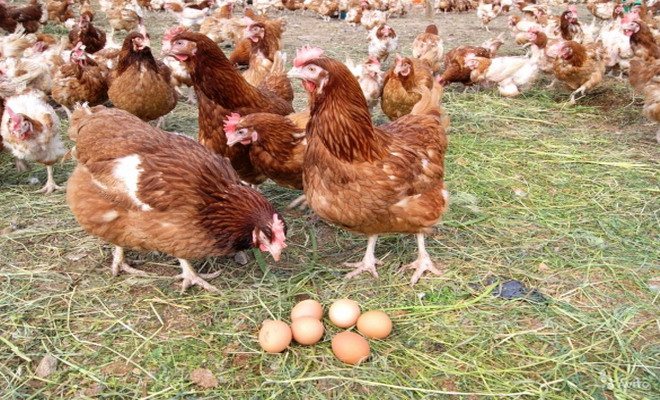

In year Rhodonite laying hens can produce up to 350 eggs... The maximum egg production is observed during the first one and a half years. In industrial conditions, chickens are not kept longer. Laying hens can be left in a private backyard for up to 3 years. The bird is oviposition early. Females begin to lay at 4 months. The mass of eggs is about 60 g. The shell is brown.
The mass of birds for laying hens is significant. The hen weighs about 2.5 kg and the rooster weighs 3.5 kg... The taste of the meat is average. It is tough and only suitable for cooking or industrial processing.
Subtleties of content
Due to its unpretentiousness to the conditions of external factors, rhodonites are successfully bred by many owners. For growing birds, both a regular barn and a specially erected room with a walking yard are suitable.
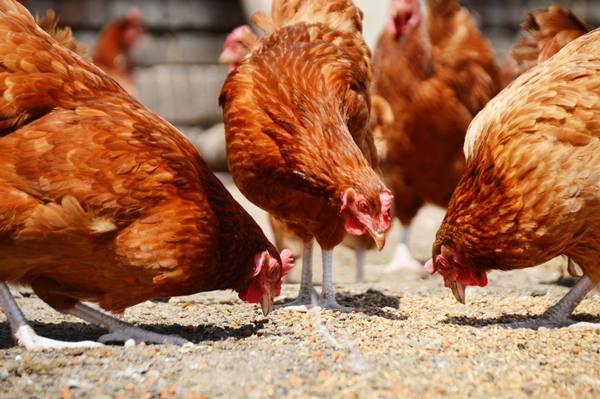

Note to the poultry farmer! Young growth (under favorable weather conditions) is released into fresh air for no more than a couple of hours. From one month old, chickens can be outdoors all day.
The area of the premises is calculated on the basis of the number of livestock and the following parameters: at least 10 square meters for 20 individuals with a wall height of 1.7 to 1.9 meters. The floor surface is covered with a litter, the role of which can be played by the following materials:
- sand;
- peat;
- sawdust;
- straw.
The main requirement put forward to the room is the presence of a good ventilation system without a draft, as well as the arrangement of free access to the walking yard.
The first parameter is easy to comply with by arranging window openings in the poultry house on the south side, or by installing exhaust pipes.
The hen house should have a roost no more than a meter in height. Tanks for feed and water are installed in such a way that the bird cannot turn them over, but at the same time can carry out an unhindered approach to them. Nest houses are installed at the rate of 1 piece for 2-3 individuals. Subzero temperatures do not seriously affect the egg-producing qualities of rhodonites, which means that during a moderate winter, heating devices can be omitted. If we turn to the opinion of experts, then it says that the temperature in the hen house should not be below zero.
Chicken breed Rhodonite
Until now, the demand for them has not decreased. Breeders continue to work tirelessly on new, more productive breeds. In this way, a few years ago, this cross turned out.
Chickens Rhodonite: description
All feathered representatives can be conditionally divided into 5 categories:
Our heroine belongs to the egg type. The main task of the breeders was to develop a breed that, under severe climatic conditions, did not reduce its productivity. The ancestors are Loman Brown chickens and Rhode Island cocks.
In the external description, the following features can be distinguished: yellow beak with a stripe in the center, shallow head, deep purple catkins and a flat, spreading comb. The feather cover is light brown in color with individual white blotches, smooth. Females weigh about 2 kg, roosters a little more - 3 kg.
Chicks can be distinguished already a few days after birth. In females, the circle near the eyes is light, in males it is dark. Females are brown with a light back and neck. Males stand out with yellow eyes.
In addition to high egg production, there are a number of advantages of the breed:
- high percentage of survival in infancy;
- quick adaptation to any environment;
- unpretentiousness to food;
- ideal for keeping in private backyards.
Among the shortcomings, the inability of chickens to independently incubate their offspring was noted. Breeding chicks on your own only possible in an incubator.
Performance characteristic
Chickens start their active productive activity 4 months after hatching. In a year, one individual is capable of laying about 300 eggs, each 60 g.
After 80 weeks, their egg production begins to decline. On an industrial scale this problem is solved by the introduction of a special vaccine. Then the useful period is extended by the same amount.
Features of the maintenance and care of chickens Rhodonite
Chickens Rhodonite are active, show no aggression towards to their fellows, they easily get along with other breeds of birds. Because of their frost resistance, they can be bred with equal success in private and industrial production. Although, in the courtyards they feel much more comfortable.
Caring for them is not difficult, and the unpretentiousness of the chickens greatly facilitates their maintenance. Only a few basic requirements should be followed.
The chicken coop cannot be lower than 1.7 m, so that it is convenient for both the inhabitants and the owner caring for them. Drafts are unacceptable, but ventilation is extremely necessary. You should adhere to a certain temperature regime from -2 to + 28 degrees. The calculation of the territory is based on the number of layers: per 1 sq. m. two units... Perches are mounted at a height one meter from floor level. Drinkers should always have water. It is recommended to install a sand box in the barn. It is regularly required to sanitize, whitewash the walls and ceiling.
The diet of chickens can include both mixed feed and ready-made. The mash usually includes: chopped vegetables, fruits, herbs, salt, chalk, mineral supplements... Some people dilute the mixture with fish broth.
Dry food is wheat and compound feed. For the quality of eggs and improve digestion, chickens are given shells, pebbles, ground shells.
Reproduction of chickens of this breed is real only with the help of an incubator. If there is none, then it is better to buy chicks at poultry farms. Even with regular replenishment of young stock from the farm, the presence of a rooster is required. Its presence does not in any way affect the ability of chickens to lay eggs, but it stabilizes discipline in the flock.
Diseases and methods of treatment are characteristic
Any birds, no matter how persistent, can get sick. And this will primarily affect its egg production. Accommodation and nutrition are the primary source of this risk. To prevent this, it is necessary to regularly disinfect in the chicken coop, feed full-fledged food for laying hens. Remember to include minerals, vitamins, and various supplements in your diet.
In a group young animals are at riskwhen their body is still very weak and not adapted to the surrounding conditions. But adults can also catch any disease characteristic of crosses. Here is a list of the most common diseases:
- Pullorosis - affects chicks less than two weeks old. Obvious manifestations are: passivity, closed eyes, lack of appetite. As a result, death is inevitable.
- Pasteurellosis - young animals are ill with it up to three months of age... If frothy-mucous nasal discharge and yellow feces are found, call your veterinarian.
- Tuberculosis - lungs and other organs are affected. The bird stops eating, the catkins fade and shrink, and stops laying eggs. In this case, it is slaughtered and burned.
- Coccidiosis - a clear sign is frequent fluid bowel movements, with blood inclusions. Urgent treatment is required, otherwise the bird will die in 5 days.
- Mycoplasmosis - swelling forms under the eyes, the chicken begins to scream unusually. For prevention, it is recommended to regularly solder them with special preparations, for example, Trilon.
- Bronchitis is a disease that affects birds and eggs... The shell becomes rough and uneven. If a chick hatches from it, then initially, it will be doomed to death. Treatment is carried out under the supervision of a veterinarian.
- Salmonellosis is the most common disease that can harm humans. Transmitted through meat and eggs.
- Gastroenteritis - the cause is poor quality and stale food.
- Parasitic damage - poultry often suffers from helminths, fleas, flies, ticks. From the first - standard anthelmintic drugs help. Ash baths that will save fleasry can take independently... For this purpose, a tank with ash is installed in the chicken coop.
According to the reviews of many breeders, it can be concluded that this breed occupies a leading position among other similar ones. Such chickens are unpretentious, give a lot of eggs, have a cheerful disposition - these are the main indicators of demand. Those who already have them in their household experience only positive emotions.
Walking space
Another feature of rhodonites is that they cannot be kept by the cellular method; chickens need regular walks. To maintain an active life, the birds are provided with a netted area next to the house. The height of the fence should not be less than one and a half meters, which is associated with the ability of chickens to fly.
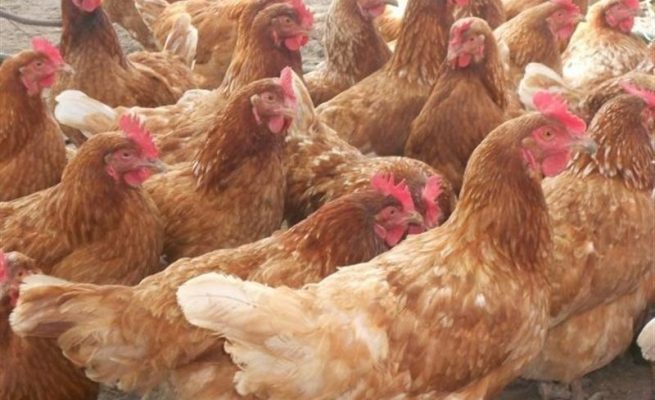

The breed was bred with the expectation of being able to withstand harsh climatic conditions. They are able to adapt to both cold and heat. In theory, rhodonites can continue to lay eggs even at -20 degrees, however, no laying hen will live long in such conditions, which will be associated with severe depletion of the body. The owner may face the same danger if for the summer he does not equip the room with a ventilation system and does not make canopies on the street. The temperature during the heat in the hen house should not reach +28 degrees or more.
The nature of the bird


Chickens breed rhodonite are distinguished by a lively temperament and high motor activity... They must constantly move, and therefore they need a spacious walk. Birds do not show aggressiveness towards the rest of the inhabitants of the hen house or relatives and can live peacefully in a common hen house.
Rhodonite grows accustomed to the owner of the laying hens quickly and are not frightened when it appears. The birds are not prone to stress, and even pullets, after being brought home, begin to rush immediately.
Feeding features
Young animals need special nutrition, unlike adults. After the chicks are born, they are transplanted into boxes or wooden boxes with sand bedding. Above are installed IKUFs for heating. As soon as the chicks are dry, they need to be given a finely chopped or mashed boiled egg. The next day, wheat groats are introduced into the diet. A day later, cottage cheese products with chopped herbs are given.
Upon reaching 10 days, complementary feeding with waste from meat and fish production begins in order to provide the growing body with the required amount of protein. As a drink, it is recommended to give not water for several days, but a manganese solution of a pale pink color, which must be changed 2-3 times.
In rhodonites, you can easily determine the sex of the chickens already on the first day of life:
- males have yellow down and chickens brown;
- near the eyes of males, the circles are dark in color, in layers - light ones.
An adult independent bird is provided with a complete diet consisting of the following components:
- grain of wheat;
- corn;
- oats;
- feed chalk;
- ground shell rock;
- green mass;
- roots;
- crushed eggshell.
It is important to know that the diet must contain enough calcium so that the eggshells form properly in layers, which must be firm. The disadvantage leads to the appearance of products in soft film.
Many farmers prefer special feeds, balanced in terms of the content of vitamins and microelements necessary for chickens.
Adult birds should receive feed twice a day, in such quantity that individuals can empty the feeders in half an hour. Faster consumption indicates a lack of food and the need to increase the portion. If food remains, then the rate decreases. obesity leads to health problems in chickens.
Rhodonites will not refuse from a wet mash cooked in fish or meat broth. In summer, it is necessary to ensure that such food is quickly eaten by chickens and does not sour in the feeders.
It is also necessary to take care of the presence of bowls of gravel or shell rock, which play an important role in the regulation of digestion in layers.
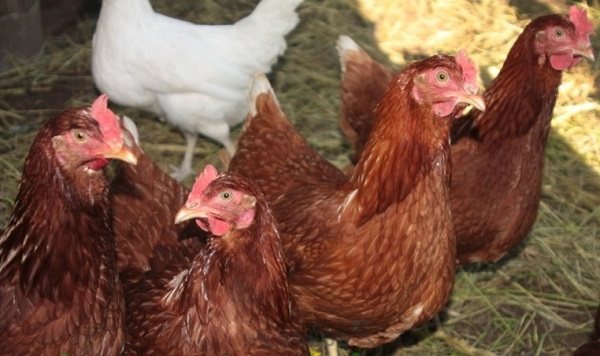

Both in the chicken coop and in the walking yard, it is necessary to install containers with water, which is just as important as the feed. Fluid change is carried out daily, and when the heat comes, twice a day. For the prevention of various diseases, instead of water, herbal decoctions based on chamomile and calendula or a manganese solution can be given weekly.
Testimonials
Andrew: Yes, I took this cross last year with an egg and day-old chicks at a poultry farm in the village of Novozavedennoe. In total, he raised about 300 females and 50 cockerels. The rooster is white with small splashes of red, the chicken is red and has white feathers in its tail and wings.
This cross is not bred. rather, the egg can be laid in an incubator. but chicks are hatched in a variety of colors. it is not clear where the chicken is. where is the cockerel. Hens were not among this cross. and I doubt that they would be hens. The eggs are laid practically every day. the egg is dark red, even somewhat burgundy. In general, here is such an experience. Now I am transferring them to meat, although there is not much to eat, but there is no point in keeping them any longer. I still prefer Kuchinskaya Jubilee.
Rhodonite is a champion in wear, over 300 eggs per year. It hatches very well in an incubator, the bird is beautiful. Wear depends on the expression regimen from the first day and timely vaccinations, the main thing is the light mode.
The optimal weight for wearing is 1.8 - 2.3 kg. At the age of 14-15 months, the lenka begins, rejuvenation regimes are developed for a month, after which they rush for another 10-11 months almost like young people. Poultry Forum
Breeding features
Selection selection has deprived the laying hens of the incubation instinct, and therefore, in order to get young animals on the farm, you will need to install an incubator, or acquire already hatched chickens at a large poultry farm.
The high survival rate of the livestock makes it easy to get chicks in a private farm. If the poultry is purchased from a third-party farm, it is recommended to buy one producer for the entire flock of layers. Its presence or absence will not have any effect on the total amount of egg production. But the rooster will keep order and discipline in the herd.
Advantages and disadvantages
Each breed, including rhodonites, has its own positive and negative qualities. The pluses include:
- productivity remains at a high level regardless of the season;
- chickens are unpretentious in content;
- adapted to the harsh climate;
- egg-laying continues even at negative temperatures;
- friendly character.
Among the disadvantages are the following:
- overly tough meat products suitable only for first courses;
- lack of maternal instinct in layers.
Typical diseases
According to the characteristics, Rhodonite chickens are exposed to various kinds of diseases mainly in the cold season as a result of drafts, low air temperatures and high humidity.
A bird that is sick walks with an open beak and behaves sluggishly. The chicks are most often sick, because they still have a fragile body, therefore, the nutrition of the laying hens is so important. With food, nutrients and minerals enter the body of birds, which help to strengthen the immune system.
Egg from hen pullets, Rhodonite breed
Laying hens. Rhodonite cross pulp. FH Volozhanina A.E.
Chickens - layers from a poultry farm. Rhodonites. February

